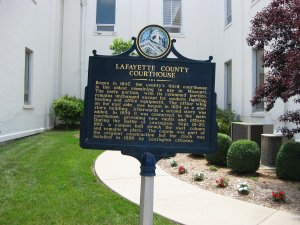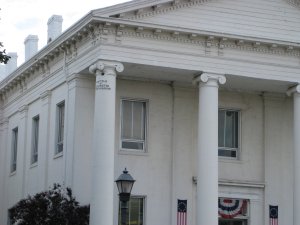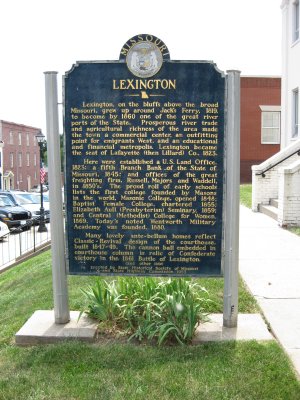 Tour Stop
Tour Stop Tour Stop
Tour StopDirections: Across the street from Price's Headquarters is the Lafayette County Courthouse [ Waypoint = N39 11.128 W93 52.972 ], located at 1001 Main Street, Lexington, Missouri 64067
From Battle of Lexington State Historic Site Visitor Center, turn right (south) onto 13th Street. Travel about 0.3 miles and turn right (west) onto SR-13 [SR-224] for about 0.2 miles. There is a public parking lot available one block north of Main Street between 10th and 11th Streets.
Description: Built in 1847, the courthouse was struck by a cannonball likely fired from Bledsoe's Battery during the Battle of Lexington. The cannonball was never removed from the column and remains visible to this day. There are two historical markers near the courthouse that may be of interest.
 |
 |
Next to the courthouse is the Lafayette County Courthouse Historical Marker:
"Begun in 1847, the county's third courthouse is the oldest remaining in use in Missouri. The early portion, with its combined portico, remains unchanged except for modern lighting, heating and office equipment. Th office wing on the east side, was begun in 1854 as a one-story building. Afterwards a second story was added. In 1939 it was connected to the main courthouse, providing new vaults and offices. During the Battle of Lexington, Sept. 18-20, 1861, a cannon ball struck the east column and remained in place. The cupola was part of the original construction but the clock was installed in 1886 by Lexington citizens."
At the corner of 11th and Main Streets is the Lexington Historical Marker [ Waypoint = N39 11.123 W93 52.949 ]:
 |
 |
"Lexington, on the bluffs above the broad Missouri, grew up around Jack's Ferry, 1819, to become by 1860 one of the great river ports of the State. Prosperous river trade and agricultural richness of the area made the town a commercial center, an outfitting point for emigrants West, and an educational and financial metropolis. Lexington became the seat of Lafayette (then Lillard) Co., 1823.
"Here were established a U.S. Land Office, 1823; a Fifth Branch Bank of the State of Missouri, 1845; and offices of the great freighting firm, Russell, Majors and Waddell, in 1850s. The proud roll of early schools lists the first college founded by Masons in the world, Masonic College, opened 1848; Baptist Female College, chartered 1855; Elizabeth Aull (Presbyterian) Seminary, 1859; and Central (Methodist) College for Women, 1869. Today's noted Wentworth Military Academy was founded, 1880.
"Many lovely ante-bellum homes reflect Classic-Revival design of the courthouse, built 1847-1849. The cannon ball embedded in courthouse column is relic of Confederate victory in the 1861 Battle of Lexington.
"In 1861, Lexington was early regarded as a strategic military prize and was occupied by Union troops to prevent the State Guard Forces north and south of Missouri River from uniting. Gen. Sterling Price moved on Lexington to break this Federal control and a bitter three-day battle ensued, Sept. 18-20, 1861, culminating in an attack called the Battle of the Hemp Bales. The Federals under Colonel J. A. Mulligan were defeated.
"Among points of interest are Lexington Battlefield; Anderson House, 1853, site of violent encounters while used as a battle hospital, now a public historic house museum; replica of Masonic College Hall; Machpelah Cemetery and grave of first settler, Gilead Rupe; 'Madonna of the Trail' monument by F. C. Hibbard, one of 12 in U.S., erected by D.A.R. To mark National Old Trails Roads; Episcopal Church, a Gothic-Revival chapel, built 1848; and Public Library and Historical Association, housed in former Cumberland Presbyterian Church, built about 1840.
"Near Lexington Bridge, completed 1925, the side-wheeler Saluda exploded in 1852. Most of the passengers, Mormans, perished."